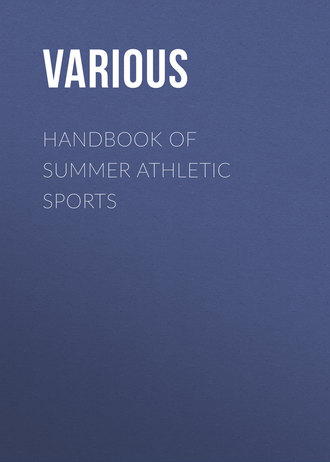 полная версия
полная версияHandbook of Summer Athletic Sports
In archery meetings two targets are used, facing each other at any distance: the archers stand by one target and shoot at the other, any number of arrows agreed on. When all have shot, they walk over to the target, pick out their arrows and shoot back at the first target, combining walking and shooting. The maximum distance is eighty yards between targets, the minimum twenty.
The dress for an archer should be close, with no fluttering skirts to entangle the bowstring, and the secrets of position and accuracy are thus laid down by archery authorities. Roger Ascham, who wrote in Queen Elizabeth's time, says:
"The first point is, when a man should shoot, to take such footing and standing as shall be both comely to the eye and profitable to his use, setting his countenance and all other parts of his body after such a behavior and port, that both all his strength may be employed to his own most advantage and his shot made and handled to other men's pleasure and delight. A man must not go too hastily to it, for that is rashness, nor yet make too much to do about it, for that is curiosity; the one foot must not stand too far from the other, lest he stoop too much, which is unseemly, nor yet too near together, lest he stand too straight up, for so a man shall neither use his strength well, nor yet stand steadfastly. The mean betwixt both must be kept, a thing more pleasant to behold when it is done, than easy to be taught how it should be done."
Maurice Thompson says:
"A little care at first will save you a great deal of trouble and annoyance. When you begin to shoot, learn at once to stand firmly on your feet, the left slightly advanced, the head easily poised, the upper portion of the body gently inclined forward, and the shoulders neither lifted nor drooped. Hold the bow vertically with the left hand, the arm extended straight. Nock the arrow well on the string, draw with all the fingers of your right hand till you feel your right ear, fix your eyes steadily on the target and let fly. The arrow rests on the left hand, and is drawn to the head. The nock end of the shaft is held between the first and second fingers of the right hand and upon the string, which is drawn to the right ear by all the fingers being hooked stiffly over it. The release must be smart and clear, giving the arrow a strong, even flight.
"Never try to take aim when shooting, but fix your eyes steadily on the mark, and guide your arrow by your sense of direction.
"Squeeze the bow-handle with the left hand. You cannot hold it too fast. Draw quickly and evenly. Let go without, 'bobbling' or tremor."
In a little story written by William Thompson (the brother of Maurice and the champion archer of the Union) there is a still more valuable piece of advice as to how to take aim. He makes one of the characters, who has hitherto always been unsuccessful at a target, hit on the secret, which he tells his friend. It is virtually as follows:
"After nocking the arrow, draw it up to the right ear with the right hand, and hold it there as if it was screwed fast. Think no more of your right hand, but point your left fist at the target and let fly."
This tells the secret of archery better than an elaborate treatise. The aim is taken with the left arm, not the right. Target shooting is, however, a bad school for learning to shoot at game, and here again Maurice Thompson comes in with his invaluable practical hints on the subject. He says:
"One who is trained to aim at a large, graduated target, either with gun or bow, can rarely shoot well at game. The reason is that in target shooting at a fixed distance he gets used to a certain size, color, and condition of background, and when he gets into the woods and lifts his bow to draw on a bird or a hare, his accustomed rings and dark background are not there. His vision is blurred, he draws waveringly and shoots indifferently. A black rubber ball four inches in diameter, suspended in mid-air by a string fastened to the low limb of an apple-tree, makes a first-rate substitute for a bird, and a small bag of straw, placed flat on the ground and shot at at about twenty-five yards, makes good hare practice. You will soon learn the great advantage of not using the same distance all the time, as in the game of archery. For, after all, a bowman's skill is scarcely worthy of admiration if it is confined to a fixed range."
A few words about the strength of bows, and we have said enough for the purposes of a little handbook.
Bows are graduated by the number of pounds' weight required to bend them. Ladies' bows range from fourteen to thirty pounds pull, while gentlemen can take from forty to sixty pound bows. The heaviest bows should be used for hunting purposes, but for target practice at short range a bow under your strength is recommended, as it is easier to take aim with such a weapon than with one that tasks all your force merely to bend it.
THE END








